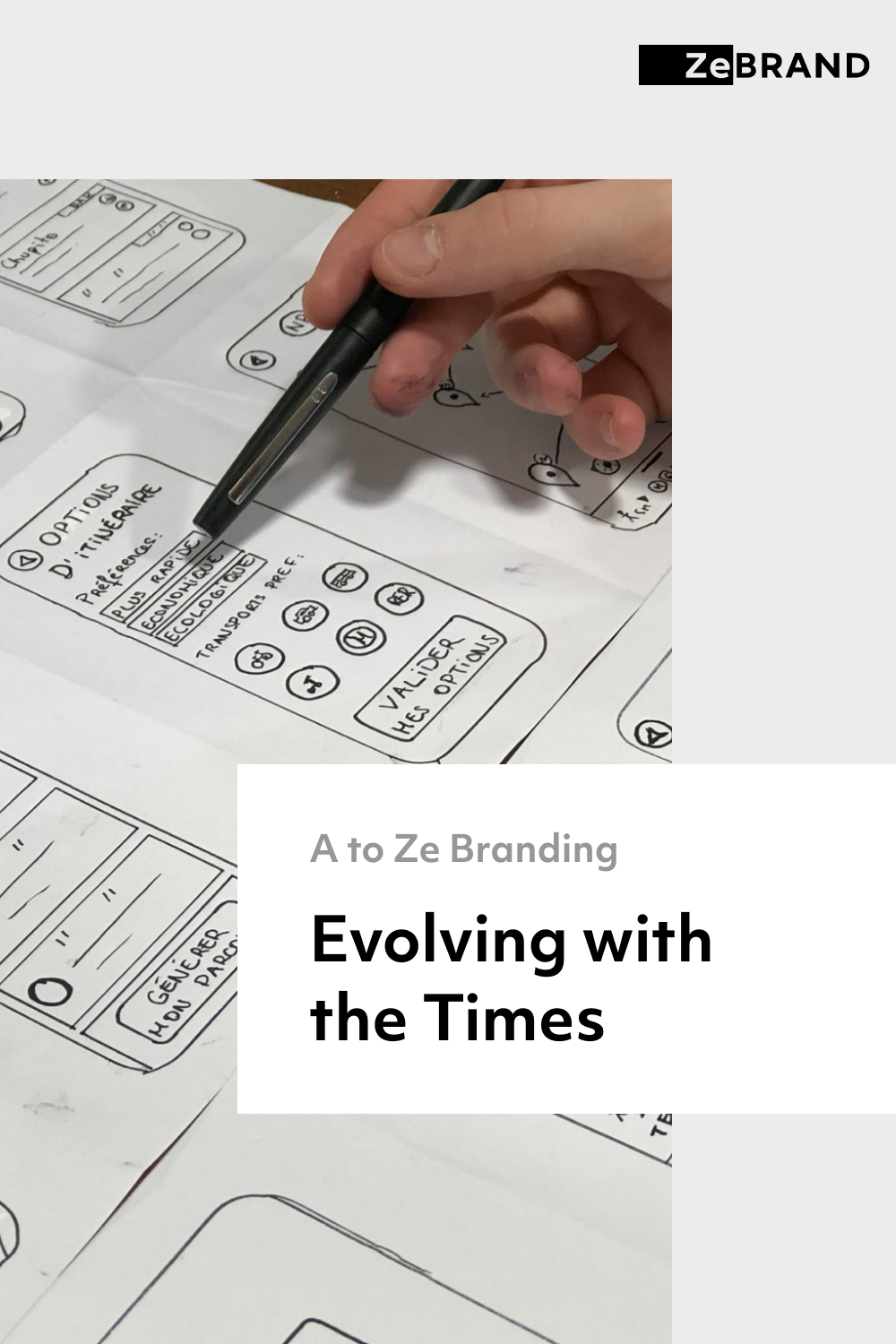Evolving with the Times

Change is inevitable and necessary. As times change, businesses change course, and so must their brands. We believe there are 5 basic responses that brands can take to respond to the world around them. But it all starts with being able to maintain your core brand identity and balance the changes required.
Photo by Amélie Mourichon on Unsplash
At ZeBrand, we believe your vision deserves to be seen and realized. In this content series, we help you use brand as a tool to power up your business and jumpstart your growth.
Welcome to Part 10 of A to Ze of Brand Building -- 'Evolving with the Times'. (Read Part 9 here if you missed it!)

Photo by stephan sorkin on Unsplash
Brands are the bridge between businesses and consumers. On both sides of this bridge there is never-ending change. On the business side, changes in economic conditions peak and trough, new legislations create obstacles, and new competitors enter the market. On the consumer's side, technology advances faster than ever, trends come and go, and socio-cultural norms continue to evolve.
Change is inevitable and necessary. As times change, businesses change course, and so must their brands. Think about brands with decades of history like IBM, 3M, or Virgin and you’ll see that their strategy and looks have changed considerably over time. Now cast your eyes to brands in the digital age — whether it’s Instagram, Airbnb, or Spotify, these brands have also looked and felt drastically different five years ago versus now.
So how do you know when it’s time for a change? And how big a change?
We believe there are 5 basic responses that brands can take to respond to the world around them. But it all starts with being able to maintain your core brand identity and balance the changes required.
Maintain your brand
It can be tempting to think that if you get your brand right at the beginning, it’s smooth sailing from there on. But in reality, brands aren’t set-and-forget. As soon as your brand is out in public, it takes on a life of its own. As it reaches a wider audience, people will come to use it and interpret it in ways you never intended. They will have different perceptions of your brand and voice their opinions, whether through social media or word of mouth. And as your business grows and produces more material, you’ll notice that communications begin to drift apart and materials deviate instead of maintaining a cohesive look.
So how can we retain control of our brands? Firstly, you need to keep your antennas up and sense the little signals that indicate the big changes to come. This could be keeping an eye on competitors that are catching up: Has the way they market their brand changed because of a new feature? Does it look like they’ll apply their IP to new industries? A more proactive approach might be to run customer interviews or surveys on a regular basis to ensure that your brand continues to deliver on its promise. Any irregularities in feedback may indicate an oncoming change as well. And most importantly, keep an eye on the future. Undertake research on what potential customers think of you, or what unmet needs they still have.
Additionally, maintaining your brand means the need for internal governance. Get your team together and gather all your material. This is especially important for team members who are involved in external communications, such as marketing, sales, and customer service. Bottle up what’s great and get a feel for where standards may be slipping and create a plan to rein it in. Communicate and gain alignment on your brand toolkit to its maximum effect by identifying some best-practice examples so that everyone shares a collective goal and model to aspire to. It’s by internally maintaining your brand and gathering external information that allow you to track and align on courses of action to take in the future.
Refresh your brand
There comes a point when you realize that your brand isn’t as functional or versatile as it once was. Maybe technology is changing and people are having to interact with your brand in new formats, for example a new dimension in VR or a tiny screen of a smartwatch. It could be that at the time your brand was created, your business was an edgy up-start ahead of its time, but now that time has passed, things are looking a bit shabby. Whether technical or creative, brands need some tweaks now and then to maintain relevance and shine.
In these cases, you may decide to simply ‘refresh’ your brand. A refresh is not a full redesign makeover, but involves fine tuning individual elements of your brand. For example, it can mean retaining the essence of your brand’s key assets, such as the logo and colors, but the refresh can be in supplementing the design system with motion, or revisiting the typeface so that it stays legible regardless of new applications. Understand which assets are timeless or sacred and which ones are flexible or past their due dates. Focus on maintaining the former group and adjust the latter elements around it to retain compatibility.
Netflix underwent a brand refresh several years ago as their streaming business began to skyrocket. As the volume of content available on the service increased exponentially and the brand went from mere platform to content producer, it needed to retain its recognizability and ease of navigation while dialing up the entertainment factor. It did so with a new, flat wordmark that was sleek and unfussy, and debuted an innovative use of grids and layouts that worked beautifully in motion and browsing experience UI.
Reposition your brand
Because of passing time and social changes, brands can also lose touch with their original meaning. Changing consumer tastes and needs may cause a brand to lose relevance and the ‘cool-factor’ that it once had. At this point, the brand might still retain its recognition and fame, but no longer brings in the same profits. In these cases, what a company might do is to reposition the brand—retain its core assets and offerings, but redirect the brand in a new direction to appeal to changing tastes, beliefs and behaviors, or to new customers altogether.
For example, companies like Ricoh may have excelled in creating printers and photocopiers in the past, but in our paperless age they have pivoted to digitizing the workplace with cloud solutions, collaboration tools, and process consulting. In the fashion world, where trends are cyclical and fleeting, repositionings are extremely common. Brands like Champion, Reebok, and FILA might go quiet for decades, overshadowed by competitors like Nike, Adidas, and PUMA, only to make a comeback as champions of all that was great in the 80s, and forcing their competitors to scramble and follow the nostalgia bandwagon.
Create sub-brands (or new ones!)
As your business grows, so will its range of products and services. As you find new applications for your proprietary technology and intellectual property, you may find yourself having to create new sub-brands. For instance, Sony has made the Playstation brand for consoles, Sony Bravia for TVs, and Sony Xperia for mobile phone products.
Especially in the case of independent products, you might have to create brands that look completely different from your parent brand, either because they target new markets and audiences, or because without a different positioning it might risk lowering the brand value of the original parent. Singapore Airlines is an example of an award-winning airline with premium services and an alluring first-class offer that people dream about. So when they entered the low-cost carrier market, they didn’t want to risk tarnishing that reputation they had so carefully built, so they launched Scoot as a whole new brand with an entirely different look and feel—an altogether fun and playful brand that has strength and value in its own right.
Sometimes the reasons for creating a new brand might be more pragmatic. Google recently did this with its holding company Alphabet—the name ‘Alphabet’ might have seemed random and confusing to some, but it was intentionally made different to save the Google brand from being ‘diluted’ by other new and not-as-established offerings. Of course, there is no one-size-fits-all for business structure and planning, so companies will need to consider the options and implications for restructuring and managing the valuations of its different units.
Rebrand
Even though brands are meant to last years of building trust and recognition, sometimes they too run their course. A business might decide that it needs to embark on a drastically different path, or to signal a big change to their consumers. In these cases, businesses may find that refreshing or repositioning the brand isn’t enough. They might choose to rebrand completely, changing not just the face they present to the world, but their logo, name, internal culture—everything is reconsidered. This usually comes with a big shift in business strategy. In 2010, two friends started a check-in app that helped friends schedule meet-ups. Today, that app has evolved and rebranded as Instagram. New business model, new name and design.
Our world never sits still, meaning the businesses and brands that sit still are the ones that get left behind. As you continue on your brand journey and in managing such a valuable asset, you’ll find yourself in situations that call for change. These could be small, incremental changes, or you may have to make a business move that drastically affects the brand itself. Whatever it is, keep your eyes and ears open and have the courage to evolve with the times—because the world doesn’t wait for brands to catch up!

A to Ze of Brand Building is a 10-part series about all things branding, with an eye to using branding to engage your customers and grow your business.


